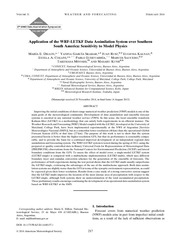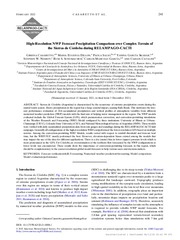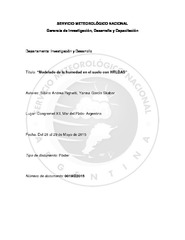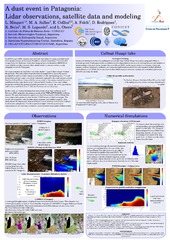Mostrar el registro sencillo del ítem
Application of the WRF-LETKF Data Assimilation System over Southern South America: Sensitivity to Model Physics
| dc.contributor.author | Dillon, María Eugenia | |
| dc.contributor.author | García Skabar, Yanina | |
| dc.contributor.author | Ruiz, Juan José | |
| dc.contributor.author | Kalnay, Eugenia | |
| dc.contributor.author | Collini, Estela Ángela | |
| dc.contributor.author | Echevarría, Pablo | |
| dc.contributor.author | Saucedo, Marcos | |
| dc.contributor.author | Miyoshi, Takemasa | |
| dc.contributor.author | Kunii, Masaru | |
| dc.date.accessioned | 2017-02-14T19:06:19Z | |
| dc.date.available | 2017-02-14T19:06:19Z | |
| dc.date.issued | 2016-02-10 | |
| dc.identifier | http://dx.doi.org/10.1175/WAF-D-14- 00157.1 | |
| dc.identifier.issn | 1520-0434 | |
| dc.identifier.uri | http://hdl.handle.net/20.500.12160/124 | |
| dc.description | Artículo publicado en la Revista Weather and Forecasting, Volume 31 No. 1 February 2016, páginas 217–236. | es |
| dc.description.abstract | Improving the initial conditions of short-range numerical weather prediction (NWP) models is one of the main goals of the meteorological community. Development of data assimilation and ensemble forecast systems is essential in any national weather service (NWS). In this sense, the local ensemble transform Kalman filter (LETKF) is a methodology that can satisfy both requirements in an efficient manner. The Weather Research and Forecasting (WRF) Model coupled with the LETKF, developed at the University of Maryland, College Park, have been implemented experimentally at the NWS of Argentina [Servicio Meteorológico Nacional (SMN)], but at a somewhat lower resolution (40 km) than the operational Global Forecast System (GFS) at that time (27 km). The purpose of this work is not to show that the system presented herein is better than the higher-resolution GFS, but that its performance is reasonably comparable, and to provide the basis for a continued improved development of an independent regional data assimilation and forecasting system. The WRF-LETKF system is tested during the spring of 2012, using the prepared or quality controlled data in Binary Universal Form for Representation of Meteorological Data (PREPBUFR) observations from the National Centers for Environmental Prediction (NCEP) and lateral boundary conditions from the GFS. To assess the effect of model error, a single-model LETKF system (LETKF-single) is compared with a multischeme implementation (LETKF-multi), which uses different boundary layer and cumulus convection schemes for the generation of the ensemble of forecasts. The performance of both experiments during the test period shows that the LETKF-multi usually outperforms the LETKF-single, evidencing the advantages of the use of the multischeme approach. Both data assimilation systems are slightly worse than the GFS in terms of the synoptic environment representation, as could be expected given their lower resolution. Results from a case study of a strong convective system suggest that the LETKF-multi improves the location of the most intense area of precipitation with respect to the LETKF-single, although both systems show an underestimation of the total accumulated precipitation. These preliminary results encourage continuing the development of an operational data assimilation system based on WRF-LETKF at the SMN. | en |
| dc.language.iso | eng | es |
| dc.publisher | American Meteorological Society | es |
| dc.subject | MATHEMATICAL AND STATISTICAL TECHNIQUES | es |
| dc.subject | KALMAN FILTERS | es |
| dc.subject | FORECASTING | es |
| dc.subject | NUMERICAL WEATHER PREDICTION | es |
| dc.subject | MODELS | es |
| dc.subject | MODELING | es |
| dc.subject | DATA ASSIMILATION | es |
| dc.subject | MODEL EVALUATION | es |
| dc.subject | MODEL INITIALIZATION | es |
| dc.title | Application of the WRF-LETKF Data Assimilation System over Southern South America: Sensitivity to Model Physics | es |
| dc.type | Article | es |



